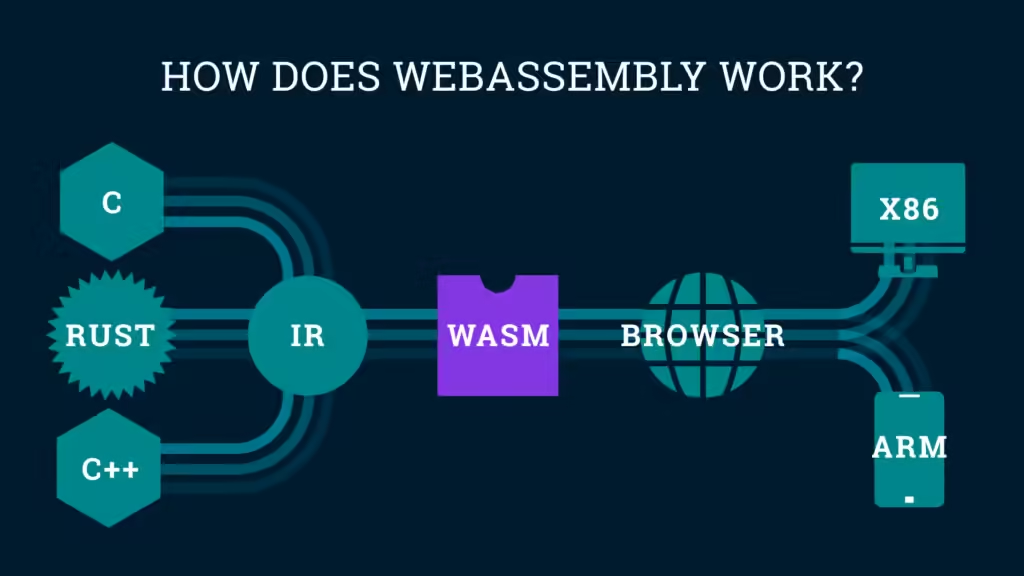As web development continues to evolve, new technologies are constantly emerging to address the limitations of JavaScript and improve the performance of web applications. WebAssembly (Wasm) is one such technology, promising near-native performance, cross-platform compatibility, and a new way to bring complex applications to the web. But is WebAssembly truly the future of web development in 2024? Let’s explore its benefits, limitations, and potential impact on the industry.
What is WebAssembly?
WebAssembly (Wasm) is a binary instruction format that enables high-performance execution of code in web browsers. Unlike JavaScript, which has to be interpreted and often optimized just-in-time (JIT) by the browser, WebAssembly is precompiled, allowing it to run at near-native speeds. Originally developed as a solution for running C, C++, and Rust code in browsers, WebAssembly has quickly expanded, becoming a go-to technology for computationally heavy applications.
In 2024, WebAssembly continues to gain traction for its ability to support complex applications, such as 3D rendering, video editing, data visualization, and gaming, all within the browser environment.

Why is WebAssembly Important?
1. Near-Native Performance
WebAssembly's binary format is optimized for fast execution, giving it a significant performance advantage over JavaScript in specific applications. This makes it ideal for compute-intensive applications like scientific modeling, real-time collaboration tools, and even gaming.
- Case Study: Major applications like Figma, Google Earth, and AutoCAD use WebAssembly to deliver desktop-like performance on the web.
- Performance Metrics: With Wasm, developers see improvements in speed and resource efficiency, especially for functions that involve heavy calculations or need quick processing.
2. Cross-Platform Compatibility
WebAssembly allows developers to reuse code across different platforms, making it easier to bring applications to the web. Developers who work with languages like C++, Rust, and Go can compile their code into WebAssembly, rather than rewriting it in JavaScript or a web-compatible language.
This cross-platform compatibility reduces development time and resources, enabling companies to quickly adapt their products for web, desktop, and mobile.
WebAssembly Use Cases in 2024
1. Game Development
With its near-native speeds, WebAssembly has become a favorite for game developers who want to bring console-quality games to the browser. High-profile games and engines, including Unity and Unreal Engine, have begun offering WebAssembly exports, allowing developers to reach wider audiences.
2. Interactive Web Applications
For applications that rely heavily on user interaction, WebAssembly is a game-changer. Platforms that require complex rendering or extensive real-time data processing—such as data analysis tools, CAD software, and video editing platforms—use WebAssembly to provide smoother user experiences.
3. Expanding AI and Machine Learning
Machine learning models typically require extensive computational power. By compiling AI models into WebAssembly, developers can run sophisticated ML models directly in the browser without server dependency. This offers a way to bring privacy-focused AI applications to the user’s device, as everything happens locally.
How WebAssembly Works with JavaScript
WebAssembly doesn’t replace JavaScript—it complements it. While WebAssembly excels at processing-intensive tasks, JavaScript remains essential for managing the DOM and handling the interactive aspects of web pages. By combining WebAssembly and JavaScript, developers can achieve the best of both worlds: Wasm handles performance-heavy calculations, while JavaScript manages the user interface and interactive elements.
Example Workflow:
- WebAssembly: Executes complex computations (e.g., physics calculations in a game).
- JavaScript: Manages user inputs, updates the DOM, and handles event listeners.
This dual approach allows developers to build applications that are both highly interactive and computationally powerful.
Challenges Facing WebAssembly in 2024
While WebAssembly offers numerous benefits, it does come with its challenges:
1. Limited Browser Support for Some Features
Though all major browsers support WebAssembly, certain advanced features are not yet universally available. This can limit the types of applications developers can build, as they may need to account for differing support across browsers.
2. Steeper Learning Curve
For developers accustomed to JavaScript, WebAssembly requires learning a new toolset and possibly a new language (like Rust or C++). Integrating WebAssembly into existing projects can be complex, as it involves building a bridge between WebAssembly modules and JavaScript.
3. Security Concerns
The high performance of WebAssembly also comes with increased risks if vulnerabilities are exploited. WebAssembly doesn’t have the same safeguards as JavaScript, so developers need to take extra precautions to secure WebAssembly code and prevent attacks.
The Future of WebAssembly: Will It Replace JavaScript?
Although WebAssembly has a strong potential to transform web development, it is not likely to replace JavaScriptentirely. Instead, it will continue to coexist with JavaScript, filling in the gaps where JavaScript’s performance and capabilities fall short.
Trends to Watch in 2024:
- WebAssembly System Interface (WASI): This standard extends WebAssembly’s capabilities beyond the browser, allowing developers to use it for server-side applications.
- Growing Language Support: More languages are expected to compile to WebAssembly, broadening its accessibility.
- Tooling Improvements: As the ecosystem matures, developer tools and resources for WebAssembly will continue to improve, lowering the barrier to entry.
WebAssembly and the Future of Web Development
As more developers embrace WebAssembly’s performance benefits, we can expect to see web applications that are faster, more efficient, and capable of handling complex tasks. In 2024, WebAssembly is helping redefine what is possible on the web, but its role is still largely supportive, enhancing JavaScript rather than replacing it.
For developers looking to stay on the cutting edge, learning how to leverage WebAssembly effectively can open up new possibilities and enable web applications to meet performance expectations more easily.
Conclusion
WebAssembly represents a significant step forward for web development in 2024. With its near-native performance, cross-platform support, and ability to handle computationally intense tasks, WebAssembly is a powerful tool for creating modern web applications. By combining WebAssembly and JavaScript, developers can build responsive, high-performance applications that meet the needs of today’s users and push the boundaries of what’s possible on the web.
Whether you’re building interactive data visualizations, games, or advanced machine learning models, WebAssembly provides the framework to deliver these experiences directly in the browser.
Internal Links
For more insights into the latest web development trends, visit our Droidmate Blog and WebAssembly tag.
External Links
- WebAssembly Official Website - Learn more about WebAssembly’s capabilities
- Introduction to WebAssembly System Interface (WASI) - Rust and WASI
- The Growing Importance of WebAssembly - Smashing Magazine

